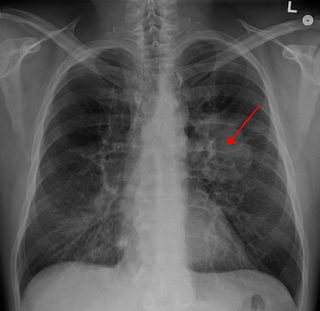Related Research Articles

Lung cancer, also known as lung carcinoma, since about 98–99% of all lung cancers are carcinomas, is a malignant lung tumor characterized by uncontrolled cell growth in tissues of the lung. Lung carcinomas derive from transformed, malignant cells that originate as epithelial cells, or from tissues composed of epithelial cells. Other lung cancers, such as the rare sarcomas of the lung, are generated by the malignant transformation of connective tissues, which arise from mesenchymal cells. Lymphomas and melanomas can also rarely result in lung cancer.

Tobacco smoking is the practice of burning tobacco and ingesting the smoke that is produced. The smoke may be inhaled, as is done with cigarettes, or simply released from the mouth, as is generally done with pipes and cigars. The practice is believed to have begun as early as 5000–3000 BC in Mesoamerica and South America. Tobacco was introduced to Eurasia in the late 17th century by European colonists, where it followed common trade routes. The practice encountered criticism from its first import into the Western world onwards but embedded itself in certain strata of a number of societies before becoming widespread upon the introduction of automated cigarette-rolling apparatus.

Passive smoking is the inhalation of smoke, called secondhand smoke (SHS), or environmental tobacco smoke (ETS), by persons other than the intended "active" smoker. It occurs when tobacco smoke enters an environment, causing its inhalation by people within that environment. Exposure to secondhand tobacco smoke causes disease, disability, and death. The health risks of secondhand smoke are a matter of scientific consensus. These risks have been a major motivation for smoke-free laws in workplaces and indoor public places, including restaurants, bars and night clubs, as well as some open public spaces.

Preventive healthcare, or prophylaxis, consists of measures taken for disease prevention. Disease and disability are affected by environmental factors, genetic predisposition, disease agents, and lifestyle choices, and are dynamic processes which begin before individuals realize they are affected. Disease prevention relies on anticipatory actions that can be categorized as primal, primary, secondary, and tertiary prevention.

UK Biobank is a large long-term biobank study in the United Kingdom (UK) which is investigating the respective contributions of genetic predisposition and environmental exposure to the development of disease. It began in 2006.

Relay For Life is a community-based fundraising event for the American Cancer Society and many other Cancer related institutions, societies and associations. Each year, more than 5,000 Relay For Life events take place in over twenty countries. Events are held in local communities, university campuses and in virtual campaigns. As the American Cancer Society's most successful fundraiser and the organization's signature event, the mission of Relay For Life is to raise funds to improve cancer survival, decrease the incidence of cancer, and improve the quality of life for cancer patients and their caretakers.

The Comprehensive Smoking Education Act of 1984 is an act of the Congress of the United States. A national program established in order to improve the availability of information on health risks related to smoking, to amend the Federal Cigarette Labeling and Advertising Act so that cigarette warning labels would be different, and for other reasons, the Comprehensive Smoking Education Act was enacted with a purpose to, as stated in Section 1 of the Act, "provide a new strategy for making Americans more aware of any adverse health effects of smoking, to assure the timely and widespread dissemination of research findings and to enable individuals to make informed decisions about smoking". Adopted by Congress in 1984 and effective October 12, 1984, the Comprehensive Smoking Education Act created a rotational warning system that required all cigarette packages and advertisements to rotate the following four warnings every three months:

Tobacco use has predominantly negative effects on human health and concern about health effects of tobacco has a long history. Research has focused primarily on cigarette tobacco smoking.

Smoking is a practice in which a substance is burned and the resulting smoke is breathed in to be tasted and absorbed into the bloodstream. Most commonly, the substance used is the dried leaves of the tobacco plant, which have been rolled into a small rectangle of rolling paper to create a small, round cylinder called a "cigarette". Smoking is primarily practised as a route of administration for recreational drug use because the combustion of the dried plant leaves vaporizes and delivers active substances into the lungs where they are rapidly absorbed into the bloodstream and reach bodily tissue. In the case of cigarette smoking these substances are contained in a mixture of aerosol particles and gases and include the pharmacologically active alkaloid nicotine; the vaporization creates heated aerosol and gas into a form that allows inhalation and deep penetration into the lungs where absorption into the bloodstream of the active substances occurs. In some cultures, smoking is also carried out as a part of various rituals, where participants use it to help induce trance-like states that, they believe, can lead them to spiritual enlightenment.

Adventist Health Studies (AHS) is a series of long-term medical research projects of Loma Linda University with the intent to measure the link between lifestyle, diet, disease and mortality of Seventh-day Adventists.

A Frank Statement to Cigarette Smokers was a historic first advertisement in a campaign run by major American tobacco companies on January 4, 1954, to create doubt by disputing recent scientific studies linking smoking cigarettes to lung cancer and other dangerous health effects.
Ernst Ludwig Wynder was an American epidemiology and public health researcher who studied the health effects of smoking tobacco. His and Evarts Ambrose Graham's joint publication of "Tobacco Smoking as a Possible Etiologic Factor in Bronchiogenic Carcinoma: A Study of 684 Proved Cases" appeared in the Journal of the American Medical Association. It was one of the first major scientific publications identifying smoking as a contributory cause of lung cancer.

The epidemiology of cancer is the study of the factors affecting cancer, as a way to infer possible trends and causes. The study of cancer epidemiology uses epidemiological methods to find the cause of cancer and to identify and develop improved treatments.

Cigarette smoking has serious health effects. In the "General health effects" and the "Unique gender differences and health effects for women" sections, this article gives specific statistics on the health effects on women and in general.
Lebanon is a small middle-income country on the Eastern Mediterranean shore with a population of around 4 million Lebanese citizens, 1.2 million Syrian refugees, and half a million Palestinian refugees. It is at the third stage of its demographic transition characterized by a decline in both fertility and mortality rates. Moreover, Lebanon, like many countries in the Middle East is experiencing an epidemiological transition with an increasingly ageing population suffering from chronic and non-communicable diseases. Mortality related to non-communicable diseases is 404.4 deaths per 100,000 individuals, with an estimate of 45% due to cardiovascular diseases, making them the leading cause of death in Lebanon. Lebanon has health indices that are close to those of more developed countries, with a reported life expectancy at birth of 80.1 years and an under-five mortality rate of 9.5 per 1,000 live births in 2016. Since the end of the 15-year Lebanese Civil War in 1990, Lebanon’s health indicators have significantly improved.
The scientific community in United States and Europe are primarily concerned with the possible effect of electronic cigarette use on public health. There is concern among public health experts that e-cigarettes could renormalize smoking, weaken measures to control tobacco, and serve as a gateway for smoking among youth. The public health community is divided over whether to support e-cigarettes, because their safety and efficacy for quitting smoking is unclear. Many in the public health community acknowledge the potential for their quitting smoking and decreasing harm benefits, but there remains a concern over their long-term safety and potential for a new era of users to get addicted to nicotine and then tobacco. There is concern among tobacco control academics and advocates that prevalent universal vaping "will bring its own distinct but as yet unknown health risks in the same way tobacco smoking did, as a result of chronic exposure", among other things.
Montenegro is a country with an area of 13,812 square kilometres and a population of 620,029, according to the 2011 census. The country is bordered by Croatia, the Adriatic Sea, Bosnia, Herzegovina, Serbia, Kosovo and Albania. The most common health issues faced are non-communicable diseases accounting for 95% of all deaths. This is followed by 4% of mortality due to injury, and 1% due to communicable, maternal, perinatal and nutritional conditions. Other health areas of interest are alcohol consumption, which is the most prevalent disease of addiction within Montenegro and smoking. Montenegro has one of the highest tobacco usage rates across Europe. Life expectancy for men is 74 years, and life expectancy for women is 79.
The 1950 Wynder and Graham Study was conducted by Ernest Wynder and Evarts Graham and was entitled "Tobacco Smoking as a Possible Etiologic Factor in Bronchiogenic Carcinoma: A Study of Six Hundred and Eighty-Four [684] Proved Cases". It was published on May 27, 1950. It was a case-control study to determine the relationship between various external factors and the development of bronchogenic carcinoma. The study concluded that long-term tobacco usage contributes to the onset of lung cancer, as an overwhelming majority (96.5%) of the men with the disease were classified as moderate to heavy smokers for an extended period of time, compared to a lower percentage of the general hospital population control group.

Lung cancer in Australia has killed more than 9,000 people and there are estimated to be over 12,500 new cases as of 2018. Lung cancer is the leading cause of cancer death in Australia and is responsible for one fifth of cancer diagnosis in the nation. It is differentiated into two different types: Non-small cell lung cancer and small cell-lung cancer. There are a range of diagnostic and treatment options available to treat both disease types. Smoking tobacco cigarettes is considered the leading risk factor of lung cancer in Australia, and Government-led public health schemes have aimed to reduce smoking and minimise its lung cancer risk. There has been relative success in these campaigns, and in treatment, as survival rates have improved from 9.2% to 17% as of 2014.Attitudes towards habitual smoking in youth and young adult groups have also subsequently changed in response to this. However, there is a growing stigma surrounding people living with Lung Cancer, and a large portion of work conducted by the Lung Foundation Australia is directed towards supporting the health and welfare of those affected.

Emily Banks is a Professor of Epidemiology and Public Health at the Australian National University. She is also a visiting professor at The University of Oxford. Banks was influential in the establishment of three large-scale long-term cohort studies in two countries: the Million Women Study in the UK, UK Biobank and the 45 and Up Study in Australia. Several of her papers have been highly influential in national and international public health policy and practice. The 2003 Million Women Study paper on hormone replacement therapy (HRT) and breast cancer was the most frequently cited paper on breast cancer worldwide in 2003–2005 and led to immediate changes in HRT prescribing policy and practice. She led the scientific elements of the 2006 World Health Organization paper on female genital mutilation (FGM) and obstetric outcome, which influenced the UN resolution on the elimination of FGM. Her 2015 paper on smoking and mortality has been used to support Australian tobacco control legislation.
References
- ↑ Boyle, Peter (2004). Tobacco and Public Health. Oxford University Press. pp. 25–26. ISBN 9780198526872.
- 1 2 3 "History of the Cancer Prevention Studies". American Cancer Society. Retrieved 27 August 2015.
- 1 2 "American Cancer Society launches third survey". Atlanta Journal-Constitution. 29 May 2012. Retrieved 27 August 2015.
- ↑ "Current Cancer Prevention Studies". American Cancer Society. Retrieved 27 August 2015.
- ↑ Thun, MJ; Calle, EE; Rodriguez, C; Wingo, PA (September 2000). "Epidemiological research at the American Cancer Society". Cancer Epidemiology, Biomarkers & Prevention. 9 (9): 861–8. PMID 11008901.
- ↑ "Cancer Prevention Study-3 (CPS-3)". American Cancer Society. Retrieved 27 August 2015.